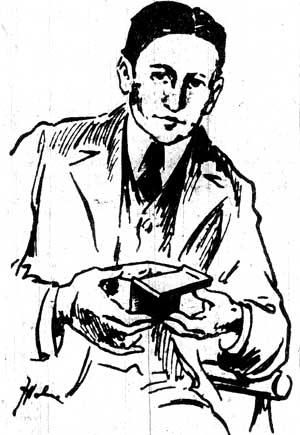
READ CHAPTER 1
GALLERY
WHO'S WHO
ATLAS
MYTHS DEBUNKED
FAMILY TREE
CONTACT THE AUTHOR
UPCOMING EVENTS
REVIEWS
CHICAGO HISTORY LINKS
READING SUGGESTIONS
BUY THIS BOOK
George Amos Dorsey

Born: February 6, 1868, Hebron, Ohio.
Parents: Edwin Jackson and Mary Emma (Grove) Dorsey.
Education: A.B., Denison, 1888, LL.D., 1909;
A.B., Harvard, 1890, Ph.D, 1894.
Married: December 8, 1892, to Ida Chadsey. Later married second wife, Sue
McLellan.
Children: Dorothy Ann, George Chadsey. At the time of Ida Dorsey's death
in 1937, she had one surviving daughter, Mrs. Marston Cummings of New York City,
which was apparently Dorothy Ann Dorsey's married name.
1891-92: Conducted anthropological
investigations in South America for the World's Columbian Exposition. Dorsey
collected items from Peru, Ecuador, Chili and Bolivia. While exploring, Dorsey
heard that a grave containing some gold ornaments and utensils had recently been
discovered on the Ecuadorian island of La Plata. Dorsey journeyed there in July
1892, finding an island of thick, scrubby underbrush and cactus, infested with
rats and snakes. One area of the island was a vast breeding ground for pelicans. The island
was uninhabited, except for a lighthouse built in 1889. The lighthouse keeper, a Jamaican, didn’t offer much help in finding the graves,
but Dorsey and his colleagues did find some skeletons with
earthenware vessels, images of gold and silver, small gold pins and beads,
several copper pins and a large stone ax. The island had enormous accumulations
of ash and charcoal, leading Dorsey to conclude it hadn’t been inhabited
year-round, but was used for religious rituals.
1892-93: Superintendent of archaeology in the Department of Anthropology for
the Columbian Exposition (World's Fair) in Chicago.
1894-95: Assistant in anthropology at Harvard University.
1895-96: Instructor in anthropology at Harvard University.
1896-98: Assistant curator of anthropology, Field Columbian Museum,
Chicago.
August 1897: A month before testifying in the Luetgert trial, Dorsey is
on a trip to the West Coast to collect Native American artifacts
Pictures: Top, Chicago Daily News, Sept. 16, 1897; later photos, true-crime magazine, The National Cyclopaedia of American Biography, Vol. 22 (New York: James T. White, 1932).
On July 4, 1922, the Chicago Tribune reported on Dorsey's divorce:
DR. DORSEY QUITS WIFE OF 30 YEARS AT BECK OF MUSE
Divorce Leaves Savant Free to Write.
Preferring to woo his muse in the temperamental atmosphere of New York's Greenwich Village, unhampered by domesticities, Dr. George A. Dorsey, famous scientist and world traveler, forsook his position as curator of anthropology at the Field museum and abandoned his home at 5703 Blackstone avenue.
The story of the defection, told by Mrs. Ida C. Dorsey yesterday, caused Judge Denis E. Sullivan to grant her a divorce and included judicial approval of an agreement between the couple, by which Mrs. Dorsey will receive increasing alimony as her former husband's income increases.
The couple were married Dec. 8, 1892, and separated in April, 1914, when Dr. Dorsey left Chicago as a member of a Field museum research expedition. He later settled in New York.
"When he came back," testified Mrs. Dorsey, "he stayed in New York and refused to come back to his home and Chicago. He became interested in his writing, and he wanted his freedom in order to write and have a career."
"We are not asking alimony," said Attorney Willard McEwen, counsel for Mrs. Dorsey. "The doctor has no means; he is living in New York a life of — I don't know — I suppose you would call it that of a bohemian. He writes incessantly and has a notion that some day he will strike a 'popular chord.'
"There is no difference between Dr. and Mrs. Dorsey, but he is possessed with the idea that in order to do this work he must be independent of domestic entanglements."
Under terms of the alimony agreement, Mrs. Dorsey will receive $50 monthly alimony, provided the doctor's income approximates $3,000 annually. Should his income be increased to $6,000 yearly, Dr. Dorsey will pay his wife $100 monthly, and $150 should he receive $10,000.
Dr. Dorsey, formerly a member of the faculty of both Northwestern university and the University of Chicago, is a member of the Chicago University club and the Cliff Dwellers, as well as numerous European and American scientific associations.
Human Behavior
In his 1925 book Why We Behave Like Human Beings, Dorsey offers the following observations:
"As one recalls some of the monstrous situations under which human beings have lived and live their lives, one marvels at man’s meekness and complacency. It can only be explained by the quality of flesh to become calloused to situations that if faced suddenly would provoke blisters and revolt."
"Man is a free moral agent and can be magnanimous and deal disinterestedly, humanity is a definite goal, social justice is desirable and possible, individual lives may be gloriously diversified, uniquely individualized, and yet socially useful; or, these are mere phrases, snares to catch gulls, soothing syrup for our troubled souls."
"The drive behind life has lost none of its power; proof that, impelled by that drive, man can build as well as destroy; that in his nature is more of Vishnu the Creator than of Siva the Destroyer."